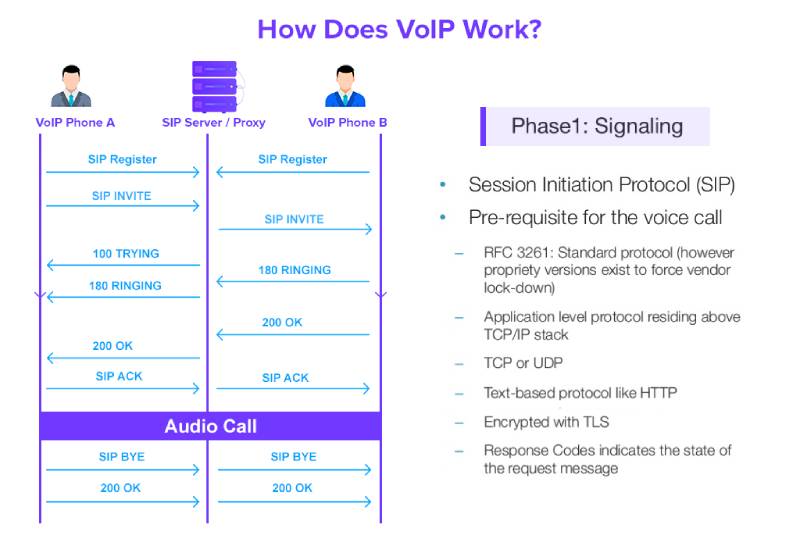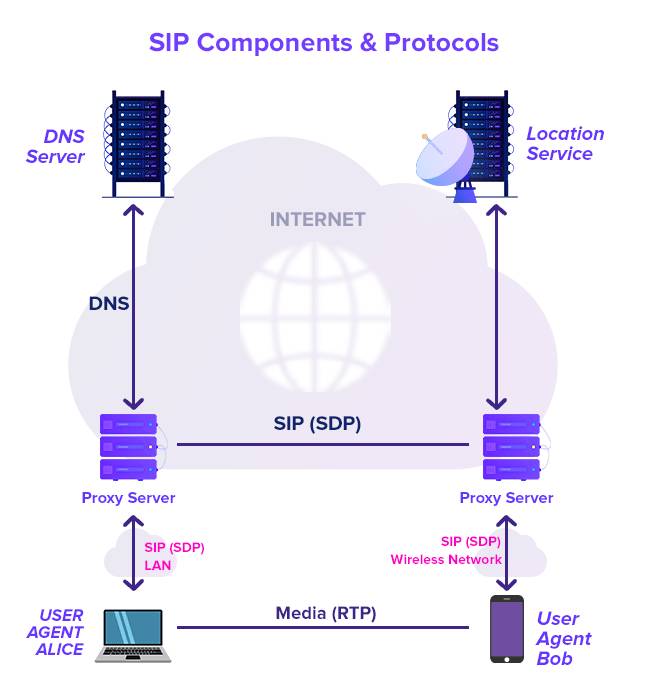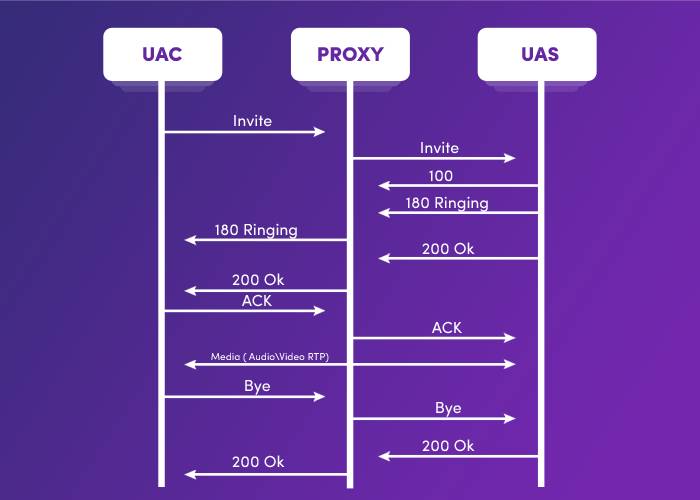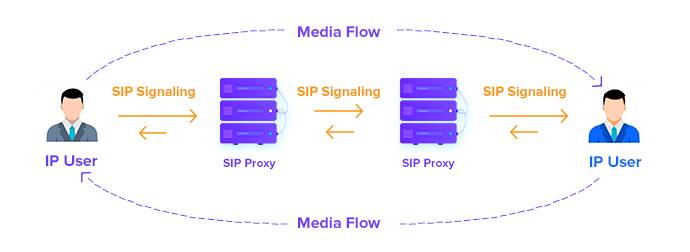How to Integrate SIP Protocol into WebRTC Application?

“WebRTC won’t replace the existing legacy VoIP infrastructure but the application will provide real-time peer-to-peer video and voice communication where the standard carrier network isn’t capable”.
To make you understand how WebRTC video chat and SIP together are used pretty great here’s some application that enhances the WebRTC and SIP technology to deliver some great applications used by millions.
The Power of WebRTC and SIP Technologies
1. Google Hangouts
It offers SMS, video conferencing, phone calls and messaging capability within all the browsers and application platforms.
2. Discord
It’s a group voice call and uses WebRTC to support in-app messaging and unlimited calls. To your knowledge, discord serves 14,000,000 callers per day.
3. Facebook Messenger
The messenger app is integrated with WebRTC to offer calling functionality better than the normal VoIP voice call services. Facebook has upgraded the WebRTC peer to peer technology to offer more than just calls to offer video calls as an act of multimedia interactivity.
Understanding SIP and WebRTC Technologies
WebRTC signaling provides an easy browser to browser communication platform without using any separate plugin that provides excellent voice and video communications in a seamless way. Also, WebRTC signaling is an open-source platform that provides the media communication to work within the website pages. In 2016 it was estimated that the number of web applications that embedded WebRTC into their browsers is around 2 billion which is a significant number. Though WebRTC integrates SIP protocol for audio/video communications it can be used to do much more functionality.

A SIP user typically accesses these SIP services usually through a VoIP which is accessed either through a mobile application or a PC. In WebRTC, the users access the WebRTC services like the WebRTC text chat for android or any other services in a traditional browser.

Whereas SIP is a signaling protocol which is mainly used for voice and video calling, WebRTC provides a more versatile option to the end-user which offers SDKs to build powerful mobile applications as well as web applications so the users can literally implement it anywhere. Apart from WebRTC video call in android phone or WebRTC voice chats in an iOS phone is made possible by the portable source code of WebRTC and it also provides webinars no matter where the client and the user are geographically put up!
Why is SIP Needed?
Though there are several signaling methods, SIP has several benefits over their counterparts. Let us briefly look into some of the advantages of SIP protocol.
1. Compatibility
As SIP is an open standard it is compatible with most of the devices including but not limited to desk phones, tablets, laptops, and much more devices.
2. Augmented Efficiency
SIP facilitates the augmented reality, which is gaining popularity in recent times. Augmented reality successfully implements the virtual image over the real-world object that receives the input either through smart glasses or camera.
3. High Scalability
According to the “Journal of Computer and System Services” from Elsevier, SIP protocol is accepted as one of the promising signaling protocols which offer great flexibility, scalability which has built-in security features that increases the overall performance of the real-time communication irrespective of the n number of users.
4. Provides Easy Readability
SIP packets are easily readable and it is simple to debug as well which efficiently controls the new services in a better way.
5. Cost-Effective Solution
The SIP setup fees with new phone lines and porting fees is comparatively low when compared to other signaling protocols. This makes the SIP protocol a more affordable solution. Also with cloud SIP trunking, there is no upfront investment is necessary where it does not require any legacy telephone lines in order to connect any public or private network.
How Does SIP Protocol Work?
Basically, SIP is the backbone of any VoIP technology which became the recent household name for all kinds of telephony devices right from desktop phones, softphones to smartphones as well. SIP was not only used for audio/video calls but also designed to streamline any other kind of communications like configuring a gaming session or operating a coffee vending machine and so on. SIP basically contains three types of components for any call flow.
1. User-Agents
When a user calls through any VoIP applications either through a software information or VoIP phone, the users communicate with the help of VoIP getaways through an application server or through any public switched network(PSTN)
2. Proxies
Next, the role of a proxy is to perform a certain logic where these proxies may either forward or reject a request according to the user’s profile.
3. Registrar Servers
The sole purpose of the registrar server is to combine the current IP address to that of the user’s VoIP address and also helps to maintain the location database.
Also, apart from these components, the three most common type of SIP requests are,
- REGISTER
- INVITE
- BYE
As the name indicates the functionality of these requests are pretty straightforward where the REGISTER requests indicates the SIP server, the SIP’s phone location address so that it can easily forward the request to the appropriate location. The INVITE request indicates the dialogue initiation between two users and finally, BYE request is the termination of this dialogue.

So What does SIP Actually Have to do with WebRTC?
WebRTC is related to all the scenarios happening in SIP. Just like SIP, it creates the media session between two IP connected endpoints and uses RTP (Real-time Transport Protocol) for connection in the media plane once the signaling is done. It uses SDP (Session Description Protocol) for describing the streaming media communication parameters.
The WebRTC differs in Two Key areas:
WebRTC doesn’t mandate the usage of SIP messages in the signaling plane, instead of the actual signaling i.e., sending and receiving of SDP messages is dependent on the application.
It also uses some optional SIP features in the media plane:
- The use of specific codes namely G.711 for audio and H.264 are required for video.
- Use of SRTP (Secure Real-time Transport Protocol) to provide maximum AES encryption & message authentication for media packets.
- It uses the Session Traversal Utilities for NAT and (STUN, TURN & ICE) for network traversal.
Before putting the points on whether the differences exist or applicable, let us take a look at the different ways to achieve it.
The Signalling Plane
Working on the assumption that your existing SIP infrastructure isn’t going to switch to a different signaling protocol, then the WebRTC has to make progress.
Here are the two ways to achieve this:
- Ensure to use SIP as your signaling stack for the WebRTC enabled applications.
- You can also use another signaling solution for your WebRTC enabled application. Make sure to add a signaling gateway to translate between the SIP and the current signaling.

The Media Plane
In order to integrate the SIP protocol into the WebRTC applications, if there is an already existing SIP infrastructure then we must add an additional media gateway known as Session Border Controller that enacts as a gateway between WebRTC and VoIP endpoints or if there is no SIP infrastructure then choosing a WebRTC compatible SIP technology which has many SIP gateways and SIP trunking services is an optimal solution.
The option you may choose completely depends on your existing infrastructure and your business idea in expanding it.
- So do you have any existing SIP infrastructure?
- To scale your WebRTC connection, do you have an SFU (Selective Forwarding Unit) or MCU (Multipoint Control Unit)?
- On which platform does your application that you want to integrate runs?
- Do you have any SIP signaling stack that runs on your preferred platform?
So choosing the right path to the solution is heavily dependent on the answer to these questions.
Messaging+WebRTC+SIP = Package of Video Solution API
MirrorFly, an enterprise messaging solution makes the SIP integration much easier by adding support for SIP to the gateway. MirrorFly’s Video Calling API is designed to allow direct communication with the SIP clients with the help of the MCU component. With complete support for both Websync, SIP endpoints and the customizable code to support the third-party signaling, MirrorFly gateway will make the signaling interconnection a hassle-free problem.
We looking for a solution which we can use to provide Voice communication between Mobile Application(Android/iOS Native) and Web Client. as well as integrating with SIP.
We are looking for a Calling Software with Call Recording and Number Masking options for integrating with our Web Application. We also need Call recording to be integrated with our Mobile APP. Thanks & Regards, A Chandra
We are planning to launch a chat and a calling application and looking for a third-party provider. Please share your API docs link and pricing for text chat, VOIP call, and Video calls. Thanks Varun
How to make PhoneCalls usin webRTC?
I’m extremely impressed with your writing abilities as well as with the structure for your weblog. Is that this a paid subject or did you customize it yourself? Anyway stay up the excellent high quality writing, it is rare to peer a nice blog like this one today.
WebRTC is very naturally related to all of this. Like SIP, it is intended to support the creation of media sessions between two IP-connected endpoints. Like SIP, the connections use the Real-time Transport Protocol (RTP) for packets in the media plane once signalling is complete..
Hi,
I’m Adrian, I live in Patagonia and i am developing a web aplication for my client in USA. I need to implement VoIP callings between users of the web app. I would like to know, which package i will need, if the API you will provide is compatible with Python3, and how much it will cost for the client…
Thanks!! we can stay in contact via mail!
Like!! Thank you for publishing this awesome article.
We have a client that would like us to build a custom teletherapy solution to integrate into their existing application. Two of the primary features they need are video and multi-user whiteboard capability in the session.
Hi
I have an query about the VOIP calling. I need to build an webapp/app for my employee to doing calling from india to worldwide. what are the pricing and support terms?
I want to about the pricing and developer API available for sip & voip Video and Voice call over network call services available in MirrorFly.
Dear Team,
We want to integrate Video Conference facility with our ERP software, I need details regarding same. Kindly provide the details.
Hello, in our platform **********.io we use TokBox API for video calling. We would like to try your solutions. Where I can find your pricing and could you provide please some trial access and your documentation?
Dear Sir/Madam, I am interested in building a voice only VOIP app for mobile. This is a startup scale. I would like to try your SDK as a potential solution to adopt. I would also want to be informed about your pricing. Thank you
Need to understand the capability as we have requirement of Voice,Video,Chat and screen sharing capability from WEB application and React native messaging app
Dear Sir or Madam, I am interested in your VOIP Calling. My questions is, if your service support calls to external numbers (e.g. mobile phone numbers)?
Best Regards
Bashkim Pätzold
We are planning to integrate chat within our web application. Its a multitenant system mainly used for all the Task management and administration. Our stack is MERN. Please share the pricing of this product.
Could MirrorFly used to implement mobile app with ability to make voice and video calls and send SMS.
Is there any integeration with xamarin cross technologies
What are the applications that demonstrate the power of SIP & WebRTC?
Here are some applications that leverage WebRTC technology to deliver some awesome user functionality
Google Hangouts
Discord
Facebook
GoToMeeting
Amazon Chime
How to use WebRTC to create a direct webcam communication application?